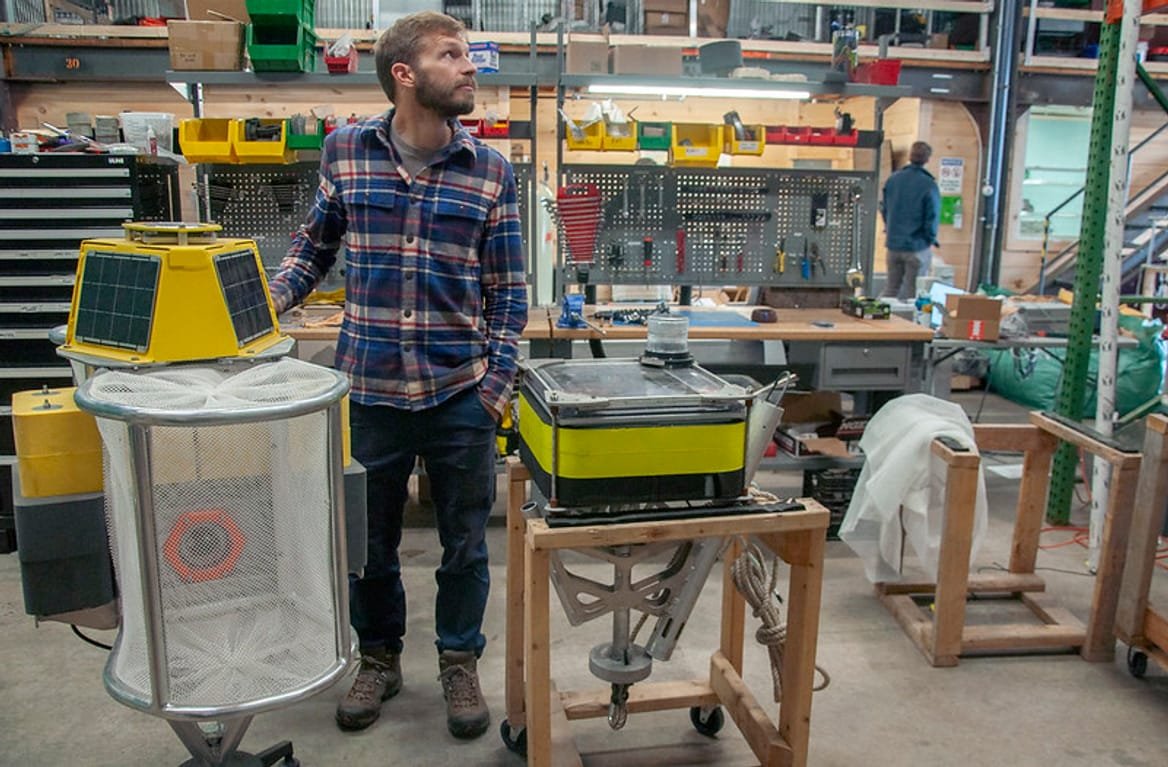






The startup made a big splash, then ran aground this summer. Its story has a lot to teach us about trying to geoengineer our way out of climate change.


For the “OK, Bye” climate conference in Reykjavík, Iceland, in May 2023, participants flew in from Silicon Valley, London, Copenhagen, and Berlin. The event’s theme was the ocean, so the stage, decorated to look like a ship, was slung with crates, ropes, and red buoys, and the backdrop an immense fishing net.
For his panel on how private enterprises can fund large-scale carbon removal, Marty Odlin, CEO and founder of Running Tide, wore an orange cap and oatmeal sweater. This led moderator Mark Phillips, McKinsey’s chief marketing officer for sustainability, to joke that Odlin — a fourth-generation Maine commercial fisherman — was the only panelist who hadn’t had to use a mood board to dress in a nautical theme, as participants had been asked to do. The audience of venture capitalists, entrepreneurs, and policymakers leaned forward as Odlin explained his company’s plan to remove carbon dioxide from the atmosphere and sequester it in the ocean by growing and sinking kelp.
“Running Tide’s solution is to make little buoys like this,” said Odlin, holding up a patty the size of a hockey puck. “We [spray] kelp spores on them and drop them in the ocean, and they float around and then sink to the bottom of the ocean. Pretty simple, right? You make a cookie — millions of them — set them free, they grow a little garden on them, and they sink.” The idea was for all the carbon stored in that freshly grown kelp to sink, too, and remain on the seafloor for hundreds of years.

Founded in 2017 as an aquaculture company, Running Tide rose to prominence in September 2020, when tech giant Shopify announced that it would be one of five recipients of a $5 million total fund for carbon-removal projects. The startup went on to raise millions of dollars from Silicon Valley funders, with carbon-removal purchases made by Stripe, the Chan Zuckerberg Initiative, and Microsoft.
Onstage at OK, Bye, Odlin made an exciting announcement: “Right now, in real time, we have a deployment going out in the North Atlantic,” he said, reaching into his backpack to reveal a small bundle of electronics — a sensor, he explained, that was part of a suite of monitoring equipment, including camera buoys, “so you can actually watch things grow.”
But Odlin omitted an important detail — Running Tide was sinking wood chips coated with lime-kiln dust, not kelp-laced buoys. In fact, last summer, Running Tide dumped 15 cargo loads of wood chips off the coast of Iceland, to fulfill its contracts with Shopify and then Microsoft.
By April of this year, Running Tide was inviting visitors to its website to purchase carbon-removal credits, promising to remove “carbon today through ocean alkalinity enhancement and biomass sinking.” The narrative pivot away from kelp specifically (biomass sinking) to a totally different concept (ocean alkalinity enhancement) was one sign among many that things were not going as planned — that Running Tide’s project had turned out not to be simple at all.
In June — just a year after the OK, Bye conference — Running Tide announced that it was folding. In a LinkedIn post on June 14, Odlin wrote, “Unfortunately, today we are beginning the process of shutting down Running Tide’s global operations because we are unable to secure the right kind of financing to continue our work with the urgency it requires.”

Startups fail all the time, but Running Tide’s demise made waves in the world of carbon dioxide removal. At its height of 140 employees, the company was one of the largest carbon-removal startups operating in the ocean — if not the largest — and the first to sell ocean carbon credits.
A big part of Running Tide’s appeal was its promise to move quickly to meet global climate goals. The U.N.‘s highly influential 2018 International Panel on Climate Change (IPCC) report on the impacts of 1.5 degrees Celsius or more of global warming stated that reducing greenhouse gas emissions will not be enough to maintain stable global temperatures. To prevent the worst effects of climate change, the world must somehow also remove decades’ worth of emissions from the atmosphere — and fast. While some nations have committed to large-scale carbon removal through initiatives such as the U.S. Department of Energy’s Carbon Negative Shot, government funding has lagged behind private capital, which has been essential in jump-starting the field.
But Running Tide’s story also points to the inherent risks of embarking on such a complex task with few if any checks in place, and little transparency about objectives and research methods. By the time of the June announcement, we’d been following Running Tide for nearly two years, and despite numerous interviews and site visits, we struggled to make sense of the company’s constantly shifting plan for removing carbon from the atmosphere.
There’s no doubt that the world needs to move rapidly to address climate change, but investing millions of dollars in untested, unvetted methods wastes not only resources but also time, when there’s none to spare. It also entrusts the ocean’s intricate, delicate ecosystems to a handful of private investors more familiar with microchips than microorganisms. Should we really try to hack the ocean to save the earth?
The first public indication that Running Tide had hit some snags came in June 2022. The MIT Technology Review published a scathing article by James Temple, whose sources reported that the company’s scientists were leaving in droves.
Running Tide had proposed growing kelp far out in the ocean in part because coastal land tends to be expensive, and the open ocean afforded the space to work at the scale necessary to affect global climate. But the startup had to address a big challenge: No species of nonbuoyant kelp grow in the open ocean.
Temple interviewed marine geochemist Philip Boyd, who explained that ocean waters far offshore lack the necessary nutrients for kelp farming. (Later, Boyd and a team modeled these nutrient deficiencies, concluding that growing kelp far from the coast was likely impossible for this reason.) Temple also reported that Running Tide had filed a patent for a flotation device whose purpose seemed to be to add nutrients to the ocean to stimulate macroalgae growth. That might help the kelp grow — but it also amounted to a form of ocean fertilization, a practice banned by a 2008 resolution of the London Convention to protect the marine environment.
Even if the startup did get kelp to grow in the deep ocean, nature’s complexities could prevent the system from removing much carbon — or any carbon at all. Temple described a study on natural kelp growth that found feedback systems involving phytoplankton and microorganisms “discounted” the carbon a floating kelp garden might remove by 20–100 percent.
In the face of these setbacks, Running Tide was contemplating a pivot, Temple reported: The company was planning to sink wood chips as a “faster” path to removing carbon. For his part, Odlin told Temple that there was “never a plan” to sink wood on its own, and that Running Tide was continuing to “devote considerable time and resources” to growing kelp, with climate-driven haste and ecological care.
The bad publicity of the MIT Technology Review article didn’t seem to scare off investors — by the spring of 2023, business was booming. That April, Running Tide and Microsoft announced they had signed a contract committing the startup to removing 12,000 tons of carbon to help offset the tech giant’s emissions. Running Tide had opened offices and labs in St. Louis; Portland and New Brunswick, Maine; and three sites in Iceland — all of them financed by investor capital, including $20 million in Series B funding from Lowercarbon Capital, a firm launched by Chris Sacca, a ground-floor investor in Twitter, Uber, and Instagram.
That May, we visited the startup’s headquarters in Portland, Maine, which was housed in the repurposed Odlin family boat-repair shop on the harbor and in the newly built Ocean Hub nearby. Nate Beatty, VP of scientific technology, and Andrew Thompson, senior mechanical engineer, showed us around.

In Ocean Hub’s lobby, a large flatscreen showed a digital map where a cluster of green dots blinked between Greenland and Iceland. This “dashboard,” Beatty explained, was delivering real-time location data from 25 “trajectory buoys” that Running Tide had just launched. Thompson, a former employee of SpaceX, showed us wiry sensor buoys his team had designed.
Another room held massive custom-built wave tanks in which straw-colored patties sloshed in gently undulating water. These, Beatty told us, were unseeded buoys being optimized for kelp growth. They needed a certain porosity and density for the kelp to spore and then mature before sinking. They also had to be sturdy enough to withstand North Atlantic Ocean conditions that were, Thompson said, more challenging than those in outer space.
Out back, in two trailers, macroalgae floated under grow lights in pet-store-sized aquariums. Was this nutrient-poor water, like that in the deep ocean? Could this macroalgae grow on the buoys? Thompson couldn’t tell us — the macroalgae experiments were being directed by Rishi Masalia, who was leading the agronomy genetics team in another laboratory, in St. Louis.
It turned out that Running Tide’s lead scientists were all working remotely: The lead ocean ecologist, Alison Tune, was based in Austin and the lead oceanographer, Anna Savage, in San Francisco. As we conducted our interviews, it became clear that this team, which had tasked itself with overcoming profound interdisciplinary engineering and research challenges, was organized less like a science lab and more like a Silicon Valley startup — loose, fluid, ad hoc, and constantly growing. It was difficult to know who was setting the startup’s research objectives, which seemed to be ever-shifting.
The following month, we traveled to Akranes, Iceland, to visit Running Tide’s lab, which was housed in a former fish-processing plant with ample space to expand. There, we saw sparse green ribbons of kelp wafting in cylindrical tubes taller than we were and tanks of kelp growing beneath infrared lights. The scientists we spoke with described their efforts to get kelp to spore on schedule, but they couldn’t tell us when the kelp would be ready to go out on buoys.
“We would be in a good spot if we were doing [kelp] successfully by 2025,” Jordan Breighner, Running Tide’s strategic and communications lead, told us later that summer. “The challenge with biology is that you can’t rush it.”

In October 2023, Breighner excitedly showed us images of rope furred with green fuzz: The team had launched a few lengths seeded with macroalgae, and several of them had grown at sea.
But the questions that Temple’s reporting raised about Running Tide’s or anyone’s ability to grow macroalgae at scale out in the deep ocean — poor in nutrients and light, with its wild waves and complex ecology — remained unresolved.
What does a startup do when it can’t get its signature product to work? In its final years, Running Tide walked an awkward scientific line, with Odlin publicly pitching kelp even as the company was quietly doing something else. When Running Tide announced the deal with Microsoft in April 2023, the word kelp was absent from the press release. At a research talk that June, Chief Technology Officer Max Chalfin asked audience members familiar with Running Tide to approach the startup with a “blank slate.”
Later that summer, when the startup serviced contracts for the “first ever large-scale marine carbon removal in the open ocean,” it did so, as a press release with funder Shopify announced, with “buoys carrying limestone and biomass.” Biomass is a capacious term that encompasses every living and dead thing on earth. In this context, biomass referred not to kelp but to wood chips — or, as Breighner described them to us, “micro-buoys.”
For Running Tide, dumping wood chips made out of dead trees was an easier and faster way to fulfill its contracts than the extremely complicated bioengineering project of growing kelp in the open ocean. The idea of storing carbon by sinking wood wasn’t new — researchers had been investigating the approach for at least a decade.
Ning Zeng, a three-time contributor to IPCC reports and an expert in “biomass burial and sinking,” holds that burying whole logs from fallen trees in nearby trenches or ponds can effectively sequester carbon. The method, he says, “benefits from its simplicity,” locking away carbon while minimizing energy used for transporting and processing.
But Running Tide was trucking and shipping wood over great distances, releasing carbon dioxide along the way. Breighner told us that in the first deployment about half of the carbon in the wood the company sunk had been “spent” in operations costs, although he added that the company later became more efficient.
The shipments were also expensive: This past May, two weeks before the company shuttered, Breighner told us that deployments would not be happening again this summer, citing their high cost (ship rental alone had cost the company $20,000 to $50,000 a day) and lack of customer interest.
Despite the deployments’ limited run, the company called them a success, saying it had “removed more carbon than any other organization on the planet,” at just over 25,000 tons. “We did the thing,” Odlin wrote in his last LinkedIn post on the company. “We removed carbon, and we increased the world’s understanding of the ocean.”
In Running Tide’s final months of operation, its website claimed that the company was removing carbon from the atmosphere in two distinct ways: through “biomass sinking” and “ocean alkalinity enhancement.” Gone were the images of kelp, replaced by aerial shots of a lush forest and bubbles rising through dark waters.
Early on, Running Tide’s researchers had realized that the wood chips they planned to sink into the ocean would leach acid as they decomposed. To mitigate this ecological hazard, they decided to coat the chips with an alkaline layer of lime-kiln dust, which before long they were describing as another method of carbon removal that the company was pursuing.

Ocean alkalinity enhancement, or OAE, has been gaining traction in the carbon-removal field, with several startups dedicated to working on it. In nature, alkaline minerals erode from mountains and wash into the ocean where, under the right circumstances, they bond to carbon dioxide in water, which changes them into stable bicarbonates. This reaction can both deacidify ocean water (it’s often likened to “giving the ocean a Tums”) and make it relatively deficient in carbon dioxide compared to the atmosphere. Researchers thus theorize that by adding alkaline materials in bulk, ocean water might be able to draw down more carbon dioxide from the atmosphere.
But there is a catch: It takes time for the atmosphere and the ocean water to equilibrate and transfer carbon dioxide molecules through a process called “air-sea gas exchange.”
For that reason, researchers who study OAE have proposed experimenting with processes relatively easier to trace than dumping alkaline chemicals en masse into the middle of the ocean, such as adding alkalinity to an existing drain pipe that feeds into a bay. They also call for creating predictive ocean models based on observations of how ocean waters rise, sink, mix, and mingle. This way, researchers can be strategic about where to add alkaline chemicals: ideally, in parts of the ocean where currents keep surface waters in contact with the atmosphere.
Running Tide would have needed to do wildly complicated science to establish that it had removed carbon from the atmosphere using OAE. That’s why, in summer 2023, the startup didn’t charge customers for the carbon that may have been removed with this method. (Breighner called it an “add on” and “a bonus.”)
Still, Running Tide did claim on its website and elsewhere to be doing OAE, with Breighner telling us that the summer 2023 deployments had been the “largest alkalinity field trials in the world.” What did these field trials teach Running Tide, or anyone else?
At the lab in Portland, we had seen an early experiment in which a technician measured pH to assess the effect of the limestone coating on wood chips decomposing in flasks of ocean water. In May of this year, Breighner shared with us a report based on these experiments, which the company relied on to conclude that its deployments the previous summer had not leached acid into the open ocean and, further, had added enough alkalinity to draw down carbon from the atmosphere. But to make these claims based on field trials, Running Tide would have had to measure the baseline values of pH and CO2 in the shifting, open waters of the North Atlantic and run models that didn’t yet exist.
Running Tide also didn’t run experiments to determine what the ecological impacts of its 2023 deployments would be in the deep sea either before or at the time it conducted them. It was only in September 2023 that the company announced a partnership with Ocean Networks Canada, to observe the buoys decomposing on the deep sea floor.

When the company folded, Brad Ack, CEO of Ocean Visions, a conservation research group that oversaw Running Tide’s science advisory board, co-wrote a rebuttal to critics and investigative journalists who had charged that the company engaged in sloppy science, taking exception to what he called “a swirl of speculation, inaccurate statements, and sweeping conclusions” about why Running Tide closed. Central to his defense was that Running Tide’s research methods had been sound. “In all our work with Running Tide, their team showed a high commitment to doing the needed science,” Ack wrote. “It is simply not accurate to suggest they did not make good faith efforts to do the needed science to support their activities.”
But there was an ocean of distance between what standard scientific research demands — a narrowed objective pursued through honed lab experiments that are progressively scaled up to large field trials — and what Running Tide’s business model called for: that is, to sell a beta, minimum viable product immediately to new customers and demonstrate value to new investors.
On the day we toured the Portland lab in May 2023, we had lunch with Odlin. He struck us as a man in a hurry. We met him in Running Tide’s airy wooden offices on the harbor. He led us down two flights of stairs at a run, then out to the street, where he delivered a karate kick to activate the pedestrian light.
Over tacos, Odlin told us about how he’d started Running Tide, a story well documented in various media profiles: Driven by a desire to save his beloved Gulf of Maine, he’d dreamt up a carbon-removal method to which he could apply his expertise with ships and logistics — one that would be big, fast, and scalable. “What would success for Running Tide look like?” we asked him. The ocean as it had been in his childhood, he answered, restored for his children.
But Odlin wasn’t proposing to make the ocean what it was before, but something altogether different. For Running Tide, the sheer quantity of material — whether kelp or wood chips — that it would need to add into the oceans to remove 1 gigaton of carbon, the threshold that investors like Bill Gates and Elon Musk are interested in funding, is staggering. Per our back-of-the-envelope calculations, it would require sinking wood chips ground from several billion mature trees a year. Now imagine doing this enough to remove 5 to 10 gigatons of CO2 equivalent from the atmosphere each year, the amount suggested by the IPCC’s 2018 1.5 Celsius report. To achieve this, Running Tide, or any other startup trying to hack natural processes for carbon removal, would need to alter whole ecosystems, which amounts to geoengineering.
At OK, Bye, Ocean Vision’s Ack gave a talk in which he likened the ocean — acidic, microplastic-laden, warming-damaged — to a patient dying on the operating table. The night before that, Running Tide’s Icelandic site manager Kiddi Hróbjartsson had spoken at an ocean cooperative event, saying, more or less, who cares about dumping a few wood chips in the ocean, when ships literally dump shit there? It drew rueful laughs. It’s so easy to see the ocean as beyond repair.
But for Craig Smith, a professor emeritus at the University of Hawai‘i at Mānoa who specializes in seafloor ecosystems, the ocean’s benthic floor isn’t ruined or a desert but “a huge reservoir of biodiversity and evolutionary novelty,” one whose very remoteness has protected it from human activity. According to Smith, “The depth of 1,600 meters” — how deep the ocean was at the site where Running Tide’s summer deployment took place — “is typically within a sweet spot for biodiversity,” where there are “deep sea ecosystems full of life that ranges from microbes to megafauna.” He warned that sunken wood can quickly become colonized by boring bivalves, which can lead to organic enrichment and oxygen depletion in the sediment, creating local faunal dead zones that can last for years.
It’s frightening to think that if something goes wrong in this lightly regulated space invisible to us, we may never know it, let alone be able to correct it. Projects like Running Tide proposing to engineer natural ecosystems to remove carbon — whether it’s by growing algae ponds on 480,000 square kilometers of pristine desert coastline or covering beaches with olivine rock — require special scrutiny. Unlike a direct-air-capture machine, you can’t turn off these experiments with the flick of a switch.
But Odlin believes that solutions to climate change that don’t engage natural systems will not be sufficient. “They’re just not going to be big,” he said when we reached him one last time, in early September. “We can’t build them fast enough.”
He spoke of the incredible harms already done to ocean systems, including almost 70 percent die-off of phytoplankton in the Gulf of Maine. “If the ecosystem is your guide, there is no justification for not doing massive scale OAE or iron fertilization,” concepts that he told us were catching on. “Geoengineers have won the war of ideas,” he said.
But who should get to decide whether or when to geoengineer the ocean? Considering the potential consequences, what the world needs, at this stage, is trusted science accompanied by peer review and largely conducted in government or publicly funded labs. That would be a slow process in contrast to the rush of typical startup culture, but it would yield papers that could be read, reviewed, and shared publicly to inform collective decision-making about if, when, and how to reengineer the oceans to save ourselves.
“I think carbon removal is a tool for the future,” David Ho, a climate scientist and cofounder of the nonprofit C-Worthy, told us. “Now is the time we figure out what works and what doesn’t work. It’s almost an obligation to future generations to give them tools to remove the CO₂ that we’re leaving them and let them decide whether to deploy these tools or not — it’s not for today.”
Before hanging up, Odlin told us he had been able to buy back what remained of the company from investors and would continue working with four employees in Portland. He wasn’t sure of the exact method they would pursue, but knew what the company would do: “carry the mission forward.”

Source link by Canary Media
Author Amanda Simson, Abby Rabinowitz
#sea #Running #Tides #illfated #adventure #ocean #carbon #removal







